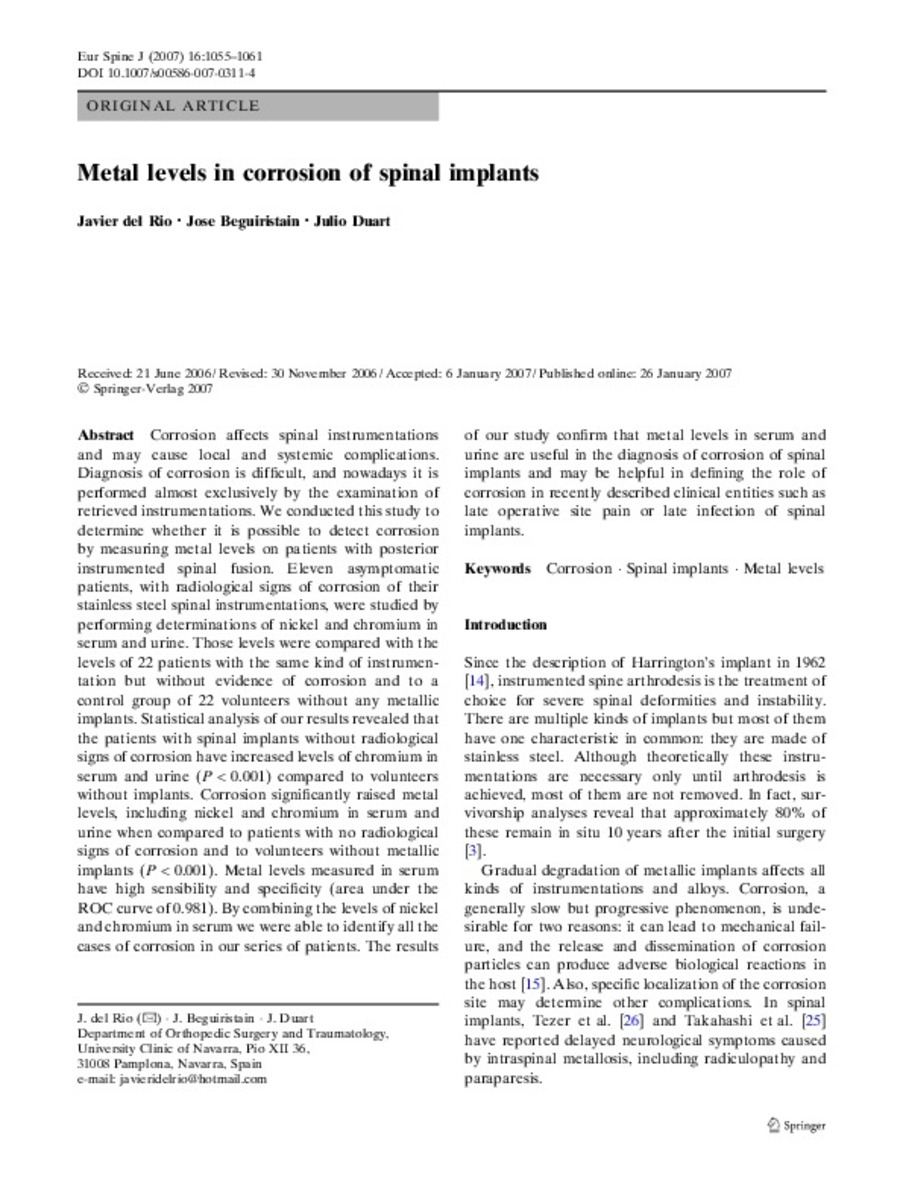Full metadata record
| DC Field | Value | Language |
|---|---|---|
| dc.creator | Rio, J. (Javier) del | - |
| dc.creator | Beguiristain-Gurpide, J.L. (José Luis) | - |
| dc.creator | Duart-Clemente, J. (Julio) | - |
| dc.date.accessioned | 2012-07-03T08:57:53Z | - |
| dc.date.available | 2012-07-03T08:57:53Z | - |
| dc.date.issued | 2007 | - |
| dc.identifier.citation | del Rio J, Beguiristain J, Duart J. Metal levels in corrosion of spinal implants. Eur Spine J 2007 Jul;16(7):1055-1061. | es_ES |
| dc.identifier.issn | 0940-6719 | - |
| dc.identifier.uri | https://hdl.handle.net/10171/22790 | - |
| dc.description.abstract | Corrosion affects spinal instrumentations and may cause local and systemic complications. Diagnosis of corrosion is difficult, and nowadays it is performed almost exclusively by the examination of retrieved instrumentations. We conducted this study to determine whether it is possible to detect corrosion by measuring metal levels on patients with posterior instrumented spinal fusion. Eleven asymptomatic patients, with radiological signs of corrosion of their stainless steel spinal instrumentations, were studied by performing determinations of nickel and chromium in serum and urine. Those levels were compared with the levels of 22 patients with the same kind of instrumentation but without evidence of corrosion and to a control group of 22 volunteers without any metallic implants. Statistical analysis of our results revealed that the patients with spinal implants without radiological signs of corrosion have increased levels of chromium in serum and urine (P < 0.001) compared to volunteers without implants. Corrosion significantly raised metal levels, including nickel and chromium in serum and urine when compared to patients with no radiological signs of corrosion and to volunteers without metallic implants (P < 0.001). Metal levels measured in serum have high sensibility and specificity (area under the ROC curve of 0.981). By combining the levels of nickel and chromium in serum we were able to identify all the cases of corrosion in our series of patients. The results of our study confirm that metal levels in serum and urine are useful in the diagnosis of corrosion of spinal implants and may be helpful in defining the role of corrosion in recently described clinical entities such as late operative site pain or late infection of spinal implants | es_ES |
| dc.language.iso | eng | es_ES |
| dc.publisher | Springer | es_ES |
| dc.rights | info:eu-repo/semantics/openAccess | es_ES |
| dc.subject | Corrosion | es_ES |
| dc.subject | Spinal implants | es_ES |
| dc.subject | Metal levels | es_ES |
| dc.title | Metal levels in corrosion of spinal implants | es_ES |
| dc.type | info:eu-repo/semantics/article | es_ES |
| dc.type.driver | info:eu-repo/semantics/article | es_ES |
| dc.identifier.doi | http://dx.doi.org/10.1007/s00586-007-0311-4 | es_ES |
Files in This Item:
Statistics and impact
Items in Dadun are protected by copyright, with all rights reserved, unless otherwise indicated.






